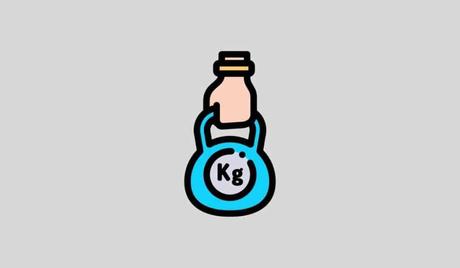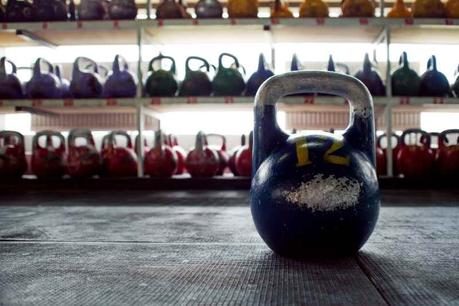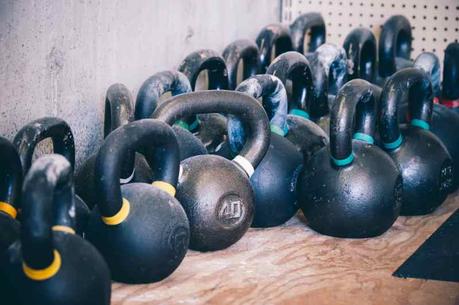Kettlebell swings are one of my favorite exercises for a full-body workout. Here’s a detailed look at all the muscles worked in kettlebell swings and some pro tips for doing them correctly.

Kettlebell swings are a beast of an exercise!
They’re an amazing addition to any workout routine because not only does swinging those kettlebells works a lot of muscles (it’s no exaggeration to say pretty much all of them), but they’re also seriously kickass cardio and a movement guaranteed to increase mobility.
Sounds like the sort of thing you want to add to your training sessions? I bet!
Below, I’ll take a deep dive into this epic resistance training movement, looking at the muscles worked, how to do it correctly, even answering some of the most common questions about kettlebell swings.
By the end of this post, you’ll know everything necessary to work them into your routines and reap the MASSIVE benefits that kettlebell swings can offer.
Let’s get to swingin’!
The Kettlebell Swing – Muscles Worked
Whether you’ve got a competition kettlebell or an adjustable kettlebell, you’re ready to get working this exercise that leads to serious muscular growth.
The best thing about kettlebell swings is that they work A LOT of muscles. Seriously, you’ll find few full-body movements that can engage as many muscles as kettlebell swings.
Every time you transition through the swinging/squatting/raising movement, you work:
- Your back muscles, including your traps and rhomboids. These create the swinging motion, keeping the kettlebell moving upward and downward.
- Your shoulders, both the posterior and anterior deltoids. These engage to raise the weight to your chest (or, in the case of overhead kettlebell swings, above your head), and to lower the weight under control.
- Your core, including your abs, spinal erectors (in the lower back), and the obliques. These work to keep your balance and provide a brace for your upper body muscles to swing the weight.
- Your legs, including your glutes, hamstrings, quads, and calves. These do the work of squatting and standing with each swing.
- Your grip muscles, including your forearms. These are necessary to hang onto the barbell.
Working all these muscles can lead to serious strength gains in virtually your entire body. (Really, the only muscles not being worked are your triceps and chest.)
Kettlebell swings do so much more than just work on your strength, though!

Kettlebell swings improve the muscles that help with good posture
They will help to improve your posture when standing and sitting.
Because you’re training the muscles that keep you upright and support your spine, they will help you stand/sit straighter, avoiding the hunch/slouch that is the cause of so many back, shoulder, and neck problems.
One of the sneaky benefits of kettlebell swings is that they’re also an excellent exercise to help improve other lifts and movements.
Because they’re so dynamic (constantly moving, never taking a break), you have to pay close attention to every stage in the swinging process—the squat, the stand, the swing, the overhead raise, and the controlled descent.
The more you work on your form, the more you’ll come to understand the mechanics of your body and how it moves most efficiently.
That knowledge will translate into better form in pretty much every other exercise you do.
Kettlebell swings help you strengthen your core
It’s also an amazing core strengthening and stabilization workout. Your lower back and abs have to brace your body through the swing, and your obliques help to keep your balance. As a result, your core grows significantly stronger.
But your balance will also improve, too, because you’re training your body to stay stable through the entire swing movement.
People with mobility issues will find that their movement both improves and increases thanks to kettlebell swings. The exercise trains your upper and lower body to move in synchronicity, to squat and swing and raise smoothly.
As a result, all of the joints involved—elbows, shoulders, knees, hips, ankles, and wrists—will move more efficiently.
Kettlebell swings work the forearms and grip
Last, but certainly not least, kettlebell swings train your grip strength.
You’ve got to hold on tightly to the kettlebell (otherwise, it could fly away and smack someone/something else!), so your forearm muscles do a lot of the work.
Training your grip strength will help you in virtually every other exercise that involves holding something heavy—either your bodyweight (like in pull-ups) or heavy weights (like when you are pulling the barbell in deadlifts or rows).

Tips for Doing Kettlebell Swings Properly
The kettlebell swing is a beginner-level exercise, one that takes minimal experience and can be adapted to any strength level.
However, it’s an exercise you absolutely want to get RIGHT—if you have the wrong form, you run the risk of injuring yourself as you swing.
Here are our best tips to help you master the technique so you activate the right muscles and avoid injuries:

Any rounding in the shoulders, lower back, or neck could cause a misalignment and back pain.
Make sure your back stays flat and your neck stays straight throughout the entire movement.

That means just swinging up to the height of your chest, and no higher. If you try to swing higher, it engages the shoulder muscles and joints in a way that could risk injury for those who haven’t yet mastered the form.

To do that, keep the shoulder muscles engaged but keep them lowered, consciously pulled down away from your ears.

Use your momentum and the thrust of your hips to facilitate movement without using your elbow or wrist joints.



With your foundation solid, you’ll have a lot more strength for the swinging action.

Try to find that pace, letting your body and the kettlebell dictate the speed. You’ll quickly settle into the rhythm and feel the momentum of the swinging weight help you to move more easily.

Keep your movements smooth and controlled at all times.

The purpose of this exercise is to strengthen your muscles, not win a title of “Heaviest Kettlebell Swinger”. Stick with a weight that feels right, and gradually increase as you grow stronger.

This will keep your muscles oxygenated and help you get in one or two more reps before hitting muscle failure.
Kettlebell Swings Muscle Worked – FAQs
Is the kettlebell swing good for abs?
The kettlebell swing focuses more on the posterior chain muscles (including your lower back and glutes), but your abs do have to engage to maintain your balance and brace your upper body through the swinging movement.
While there are other exercises better-suited to developing powerful abs, the kettlebell swing will be a great addition to any core-centric workout.
Can you build muscle doing kettlebell swings?
Absolutely! The combination of swing/squat/stand/raise will engage all of the muscles I listed above.
Pushing your muscles to the point of failure will force your body to increase energy storage (increasing muscle fiber count and size), which translates into bigger, stronger muscles.
How heavy should a kettlebell be to build muscle?
Exactly as heavy as you can handle!
Let’s be honest: some people can just naturally lift more weight than others, and that’s totally fine. A 250-pound linebacker will swing a much heavier kettlebell than a 100-pound Yoga instructor.
The weight itself isn’t what matters, but how hard it works your muscles. You should aim for 60 to 70% of your total 1-Rep Max weight for a 10-rep set of kettlebell swings. That’s how heavy your kettlebell should be to build muscle.
The Bottom Line
Kettlebell swings are an absolute game-changer for anyone trying to build strength, mobility, and agility.
Because it combines a squat with a swing, it works pretty much the entire body—from shoulders to calves, and everything in between.
The exercise is also a lot of fun, improves your ability to move/squat smoothly, and develops explosive power.
Follow the tips I shared above to master the kettlebell swing form, and you’ll have everything you need to shred muscle and build serious power thanks to this amazing dynamic movement.
More Kettlebell Guides and Resources

10 Benefits of Kettlebell Swings (And Should You Do Them Every Day?). Kettlebell swings are a simple exercise that pack a huge punch. Here are ten benefits of kettlebell swings, from improving your posture to burning belly fat.
